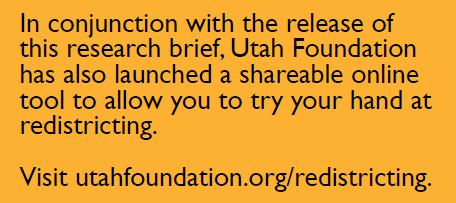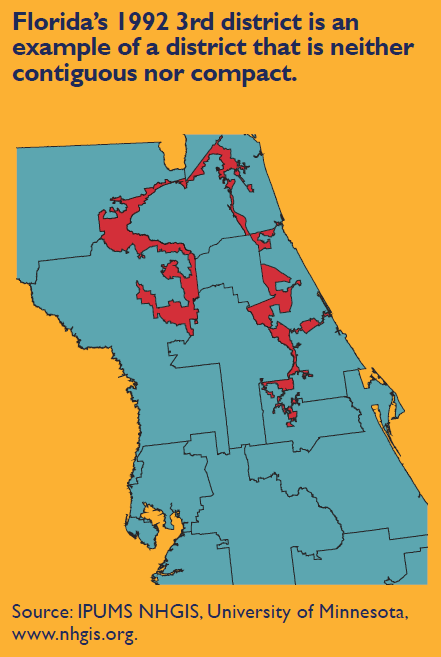The U.S. Census Bureau began counting the country’s population early in 2020, but April 1 is officially Census Day. Every 10 years, as laid out in the Constitution, the U.S. apportions representatives among the states based on where residents live as of April 1.1 In turn, each state determines the district boundaries of the apportioned representatives.
Utahns in 2018 passed Proposition 4, a ballot initiative creating an Independent Redistricting Commission to advise the state legislature regarding district boundaries for congressional, legislative and state school board districts. During the 2020 General Session, the Utah Legislature passed a bill replacing the language from the proposition.
Utah Foundation presents this research brief and an interactive redistricting tool to help voters and policymakers further understand redistricting and the challenges surrounding the process.
Gerrymandering
Nationally, policymakers have at times tried to “game” the redistricting process to ensure a desired outcome – whether that be the election of a representative from a particular party or race, or with a specific interest, or even the election of a specific person. The finessing of borders to achieve a politically desirable outcome is often called gerrymandering.
Gerrymandering – named in 1812 when Elbridge Gerry of Massachusetts approved the creation of a district that was said to resemble a salamander – generally happens in two ways: packing or cracking.2 Packing involves designing a district that puts as many undesired votes into just one district, thereby limiting the impact of their vote. Cracking takes the opposite approach, where undesired votes are divided up as many ways as possible to dilute their impact across districts.3
The Voting Rights Act prohibits gerrymandering in a manner meant to diminish the representation of voters by race or language.4 However, the legality of gerrymandering in order to allow the incumbent (or current representative) to be re-elected or in order to ensure the dominance of a specific political party has been the subject of ongoing debate at the national level.5
Individual Sorting
While gerrymandering has often been cited as the reason fewer congressional districts are competitive, individuals may simply choose to live in areas where similar politically minded individuals also live. One example at the local level might be that a family with strong Democratic party leanings might choose to live in Salt Lake City near Liberty Park, where 70% to 80% of voters selected the Democrat senatorial candidate in 2018.6 Conversely, a family with strong Republican leanings might choose to live in Riverton, where 70% to 80% of voters selected the Republican senatorial candidate in 2018.7 How much impact individual sorting and gerrymandering has in the reduction in competitive congressional districts is a matter of debate.8
Addressing Gerrymandering Legally and Politically
While partisan gerrymanders have often been attacked in court, the U.S. Supreme Court has avoided striking them down.9 Only recently, in 2019, did the court finally determine that partisan gerrymandering was not a topic on which the U.S. Supreme Court could even rule.10 However, there are instances of courts ruling partisan gerrymandering to have violated their state constitutions.11
There has been movement in recent years to find a “fair” way to redistrict, though fairness can be interpreted in many different ways.12 Still, using the quest for fairness, states like Utah have created independent commissions to conduct or advise on the redistricting process.
Utah’s Redistricting Principles
While the 2018 Utah ballot initiative outlined a prioritized list of seven principles for redistricting, the 2020 legislation added three more principles and reorganized all 10 of them into two main groups: mandatory principles and principles to be implemented to the extent practical.13
The mandatory principles are:
- Equal population. Prior to 1960, different districts could have vastly different populations. There were examples of districts in California where the largest district had 422 times as many individuals as the smallest district. However, the U.S. Supreme Court has since determined that congressional districts should be as equal as possible.14
- Single-member districts. One way to limit gerrymandering is to limit the number of districts that divide up coherent communities by allowing a larger geographical district to elect multiple individuals rather than dividing the area into smaller districts that elect one individual each. Federal law requires that members of the House of Representatives be elected by single-member districts15 (whereas the U.S. Senate is an example of plural-member districting, as the entire state elects two senators). The Legislature included this provision to avoid multi-member districts within state-level elected bodies, such as the Legislature itself.
- Contiguity. No part of a district should be separated from another part. However, some districts may be considered contiguous if connected only by a thin stretch, or two areas might be contiguous but separated by mountains or large bodies of water.
- Compactness. Oddly shaped districts are considered a red flag for gerrymandering. As a result, a traditional redistricting principle of compactness has been used to fight against contorted boundaries and how spread out a district is. While compactness may seem straightforward, using Utah Foundation’s redistricting tool will demonstrate to the reader that this can be both a challenge and a matter of interpretation.16
Priorities to be implemented to the extent practical include:
- Preserving Communities of Interest. This priority accepts that sometimes communities that develop organically do not line up according to their respective cities or counties. This priority focuses on not dividing up groups of people that consider themselves similar or share common concerns.
- Preserve geographical and man-made boundaries. Sometimes geographical boundaries, rivers, lakes, mountains, etc., can divide otherwise contiguous areas on a map. The 2020 legislation added man-made boundaries in addition to geographical boundaries. Taking physical boundaries into consideration may help preserve communities of interest.
- Preserving the core of prior districts. This is a principle that prioritizes the continuity of representation, not necessarily one that addresses gerrymandering. In fact, it may be interpreted as benefiting incumbents. This principle was added in the 2020 legislation.
- Minimize division of municipalities and counties. Priority should be given to keeping cities or counties intact within districts. However, the priority of having an equal population prevents this from happening consistently across Utah; for example, there are simply too many people living in Salt Lake County for it not to be contained within one congressional district. For state legislative districts, the fact that each district does not need to have exactly equal population like congressional districts could help reduce the division of cities and counties.
- Maximize the agreement of boundaries between different types of districts. Districts of state representatives, state senators and congressional representatives should stack well. If this could be executed perfectly, everyone with the same state representative would also have the same state senator and congressional representative.
- Prohibit the purposeful favoring or disfavoring of a party, incumbent or potential candidate. This principal seeks to expressly reject the controversial but currently legal purpose of partisan or incumbent gerrymandering.
Conclusion
While the law is clear about what the redistricting commission should consider, it should be remembered that the commission acts as an advisory body. It will prepare four options to present to state legislators.17 The Utah Legislature will then either choose one of the four maps or make its own map. We invite readers to try their own hand at congressional redistricting by using Utah Foundation’s online tool.
1 U.S. Const. Art. 1, § 2.
2 Levitt, Justin, “A citizen’s guide to redistricting,” Brennan Center for Justice, (2010), p. 8, brennancenter.org/sites/default/files/legacy/CGR%20Reprint%20Single%20Page.pdf.
3 Ibid. pp. 57-61.
4 Whitaker, L. Paige, “Congressional redistricting and the Voting Rights Act: A legal overview,” Congressional Research Service, p. 2, https://fas.org/sgp/crs/misc/R42482.pdf.
5 See for example: Olalde, Mark and Ashley Wong, “Supreme Court punts on partisan gerrymandering, sets up fight in the states,” The Center for Public Integrity, (Jun, 27, 2019), https://publicintegrity.org/politics/state-politics/supreme-court-gerrymandering/; Kilgore, Ed, “The debate over gerrymandering is changing in a fundamental way,” New York Magazine, (Feb. 20, 2018), http://nymag.com/intelligencer/2018/02/the-debate-over-gerrymandering-is-fundamentally-changing.html; Von Spakovsky, Hans A. and Michael Watson, “Partisan gerrymandering: Courts should keep out of the debate,” National Review, (Jun. 23, 2019), https://nationalreview.com/2019/06/partisan-gerrymandering-supreme-court-cases-maryland-north-carolina/; National Constitution Center, “Latest partisan gerrymandering decision adds to growing debate,” National Constitution Center, (Jan, 10, 2018), https://constitutioncenter.org/blog/latest-partisan-gerrymandering-decision-adds-to-growing-debate.
6 Data available from the Salt Lake County Clerk’s Office. See https://results.enr.clarityelections.com/UT/Salt_Lake/92254/Web02.214799/#/rpt.
7 Ibid.
8 Enten, Harry, “Ending gerrymandering won’t fix what ails America,” FiveThirtyEight, (Jan. 26, 2018), https://fivethirtyeight.com/features/ending-gerrymandering-wont-fix-what-ails-america/; Dews, Fred, “A primer on gerrymandering and political polarization,” The Brookings Institution, (Jul. 6, 2017), https://brookings.edu/blog/brookings-now/2017/07/06/a-primer-on-gerrymandering-and-political-polarization/; Feuerherd, Peter, “Is gerrymandering to blame for our polarized politics?” JSTOR Daily, (Mar. 19, 2018); Weigel, David, “Gerrymandering and the Big Sort fallacy,” Slate, (Sep. 8, 2014), http://slate.com/blogs/weigel/2014/09/08/gerrymandering_and_the_big_sort_fallacy.html; Florida, Richard, “America’s ‘Big Sort’ is only getting bigger”, Citylab, (Oct. 25 2016), https://citylab.com/equity/2016/10/the-big-sort-revisited/504830/.
9 National Conference of State Legislatures, “Redistricting and the Supreme Court: The most significant cases,” National Conference of State Legislatures, (April 25, 2019), https://ncsl.org/research/redistricting/redistricting-and-the-supreme-court-the-most-significant-cases.aspx.
10 Soronen, Lisa, “Supreme court holds partisan gerrymandering claims may not be litigated,” National Conference of State Legislatures, (Jun. 27, 2019), https://ncsl.org/blog/2019/06/27/supreme-court-holds-partisan-gerrymandering-claims-may-not-be-litigated.aspx.
11 Sneed, Tierney, “Court finds NC partisan gerrymander a violation of state constitution,” Talking Points Memo, (Sep. 3, 2019), https://talkingpointsmemo.com/news/north-carolina-partisan-gerrymandering-state-court-decision; The Public Interest Law Center, “Pennsylvania redistricting lawsuit,” The Public Interest Law Center, (2018), https://pubintlaw.org/cases-and-projects/pennsylvania-redistricting-lawsuit/.
12 National Conference of State Legislatures, “Redistricting Commissions: Congressional Plans,” National Conference of State Legislatures, (Apr. 18, 2019), https://ncsl.org/research/redistricting/redistricting-commissions-congressional-plans.aspx.
13 See the proposed initiative, “Utah Independent Redistricting Commission and Standards Act,” on Utah’s state website; “Redistricting Amendments” 2020 SB 200, https://le.utah.gov/~2020/bills/static/SB0200.html.
14 The current rule of thumb is about 10% variation is acceptable. See Levitt, Justin, “A citizen’s guide to redistricting,” Brennan Center for Justice, (2010), p. 44 https://brennancenter.org/sites/default/files/legacy/CGR%20Reprint%20Single%20Page.pdf.
15 2 U.S.C. § 2c (1967).
16 Niemi, Richard, Bernard Grofman, Carl Carlucci and Thomas Hofeller, “Measuring compactness and the role of a compactness standard in a test for partisan and racial gerrymandering,” The Journal of Politics, (1990).
17 “Redistricting Amendments” 2020 SB 200, https://le.utah.gov/~2020/bills/static/SB0200.html.



